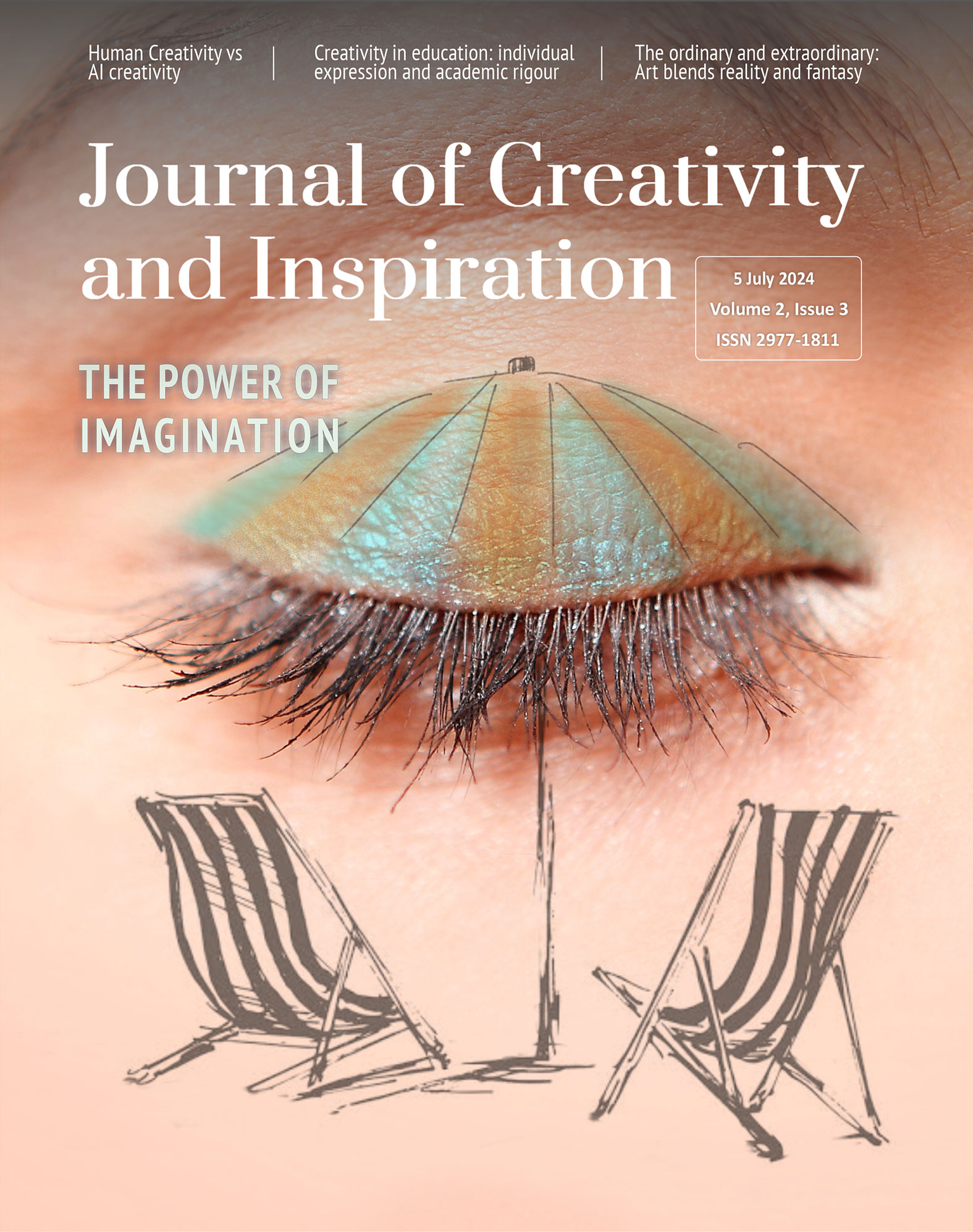The art of truth: Shira Barzilay interviewed by Gil Dekel
5 July 2024 – Vol 2, Issue 3.
Gil Dekel: I think you mentioned that artists need to realise their inner voice?
Shira Barzilay: For me, to make art and to be an artist means to tell the truth, to be truthful. And in order to achieve this, there is a process of peeling, of linking, and being able to get to the interesting stuff inside. There is a relationship between myself and my inner self. It is like a dialogue. It does require the right conditions to work; for example, I need to have silence.
I could talk for hours about the process of creating art, but I still wouldn’t be an expert, because it is a process of learning. So, every time I’m creating, I’m learning something new about myself and about the process. It is like a never-ending well.
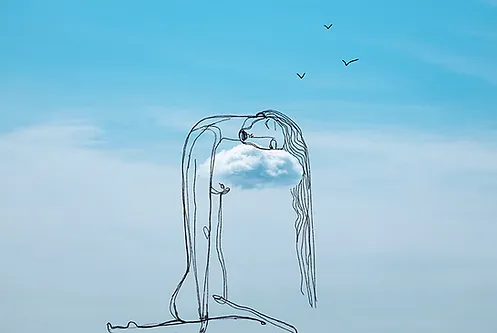
‘Power nap’, digital (drawing on photo), 2021.
Gil: And artists also need courage; courage to express what they find inside?
Shira: They need ultimate liberation. When we were children, we were taught to draw inside the lines. My approach towards art is to draw not just outside the lines, but also to recreate the line itself. That kind of thinking requires that we break a lot of barriers. I try to practice freedom – as ironic as it sounds, it does require practice…
In order to do that you need to have strong conviction, rather than courage. Conviction in your goal. The destination is unknown but as long as you trust yourself, it is okay. It is fine. So, I wouldn’t say we need courage – is a child courageous? Children draw freely, not out of courage, but out of freedom. Children did not yet put layers of life on them, with insecurities and self-doubts. A child is more pure, and later on, life experiences make them start to doubt and check on themselves. That’s very detrimental for the art process because you want to shed all of that, and make something that is painfully truthful. That takes conviction.
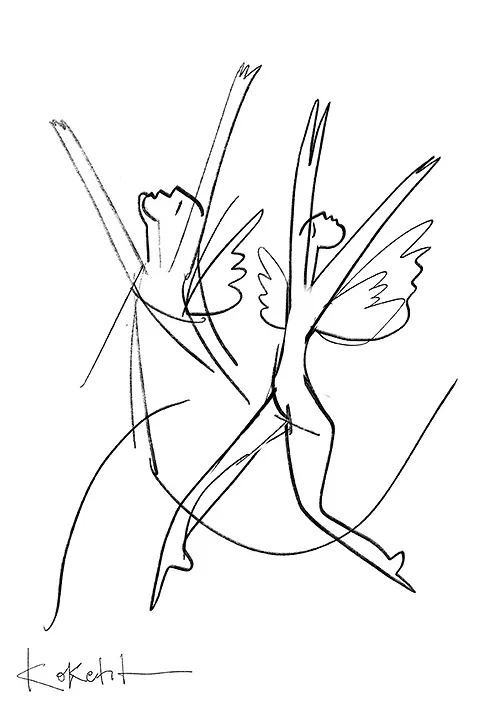
‘Angels dancing’, digital, 2023.
Gil: We talk about freedom, and yet, some of your art is line drawing. A line is very precise, defined and sharp – it is a statement. This is almost the opposite of freedom, in a way?
Shira: The line is fluid. It is like an uncharted journey, even though it is very poignant, very sharp. Because a line is so present, it enhances the tension between being present and going for freedom. When I draw the hand goes freely. And so the line is free, even though it is strong. I’m not tracing, and I do not plan where the line is going to go. I allow my head and thoughts to be somewhere else, and my hand is being led by intuition. The line is a representation of letting go.
You also have to take a chance. If I give a blank piece of paper to an adult, who is not a painter, and I ask them to draw something, then usually they will hesitate and create a very cautious line; very light, not taking up too much space on the page, and insecure. I would say to them, ‘Just go for it. Fill up the whole page; make the line as distinct as possible. And if you make a mishmash then just own it.’ Go into it with a conviction, and believe that what you make is art.
The practice of the line isn’t the main element of art, for me. What is art? It is what stands behind who I am, what I’m bringing forth, my point of view of the world.
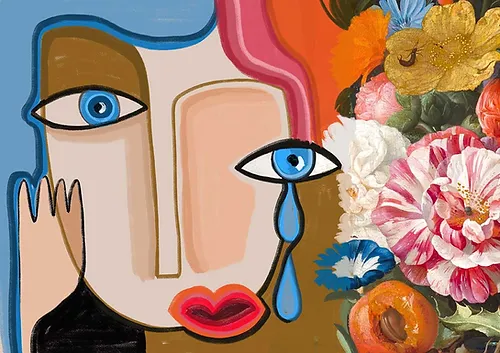
‘Crying’, digital, 2022.
Gil: Your line art reminds me of writing.
Shira: There may be an element of calligraphy, I guess. I perceive calligraphy as very precise. Calligraphers are able to create precision, and I do not perceive my technique as precise. Quite the contrary. I draw really fast. I do not care about precision. In that sense, it is very different.
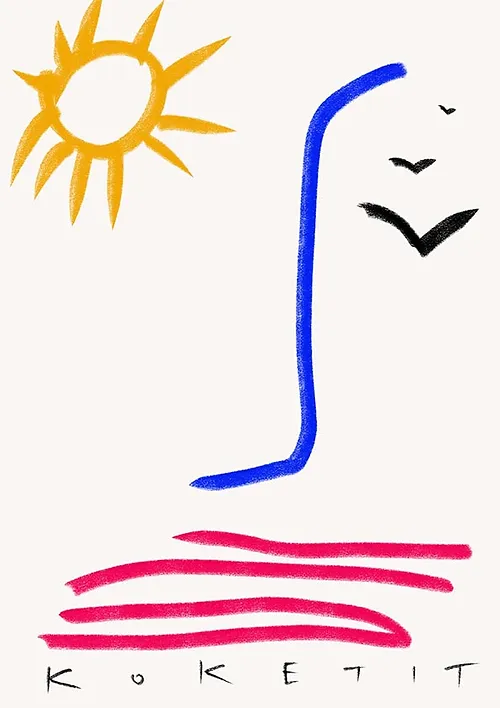
‘Vacances’, digital, 2022.
Gil: You mentioned working with the ‘Muse’.
Shira: Yes; that’s a really big thing for me. I read a biography by an artist, talking about having a weight on the shoulders as a result of being a successful artist. This was something that they were struggling with. And because it is one person, there is a lot of ego. It is a situation that if one is successful, your ego goes through the roof. They talked about the Muses as an outside source that comes and helps them. The Muses co-create, co-collaborate. I really related to this, because I feel like when you let go, you become a channel and something like your subconscious is helping you create. You can call that subconscious, but it does not feel like subconscious. It feels like something else is with you. I call it the Muses. It feels like a butterfly sitting on my shoulder, and you do not want to scare it. You really want to respect it.
You need to have perfect conditions for the Muse to appear, as she will only come if you are showing that you’re ready. If you’re serious, if you’re focused, and in practice mode. It is not going to appear all of a sudden. It is only coming to you after you have declared that you are open. It feels very pragmatic. Yes, I have to bring myself to a meditative state where something else can come out of me.
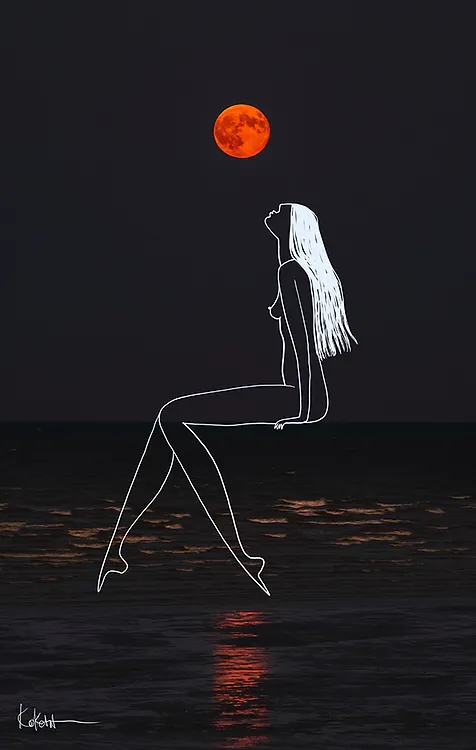
‘Solitude’, digital (drawing on photo), 2023.
Gil: It is interesting that you need to be focused to go into that state. Other artists say the opposite – that when they do not focus or get prepared, that then inspiration hits.
Shira: I have to have the right intention. For me, it is all about the intent. I can’t force it. Sometimes I really want to create, but the Muses do not come. If it is not coming, I put down the pen, and I go to do something else. But for me, the intent is the ultimate summoning of the forces and the mood.
Gil: How do you put the intent forth?
Shira: It is like a cocktail of thoughts. I strive to be a very balanced person. So, I have very pragmatic ambitions. And I also have goals to not just be creative, but also to be very smart about my decisions. And I wish to have a perfect combination of those two, which is why I consider myself more of a visionary than a practitioner. I’m not the painter who is an expert in mixing paint. I can’t give you a talk on different types of brushes. But I might have a very developed imagination. And I think my ultimate tool as an artist is to ignite that imagination to come up with visionary ideas that can be manifested.
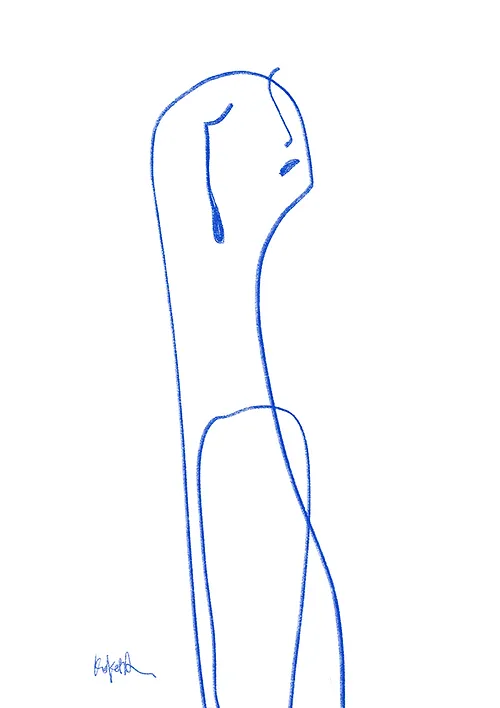
‘A mother’s tear’, digital, 2023.
Gil: So how does it feel when it does work, and the Muse does come to you?
Shira: It is like turning the car engine and driving, not wanting to stop the drive. You just want to ride the course. And you just go until you feel like it is done, where you feel you have peaked.
Once the work is complete it is the best feeling because you are looking at what you made for the first time. You are appreciating it, and being the first person to see it. With that one moment, I’m the only person in the world who sees this creation. I know that soon I will share the work with the world. And maybe someone will want to commission a project based on the painting where they will turn my digital art into 3D. This will open up new possibilities. And it is exhilarating; it feels magical.
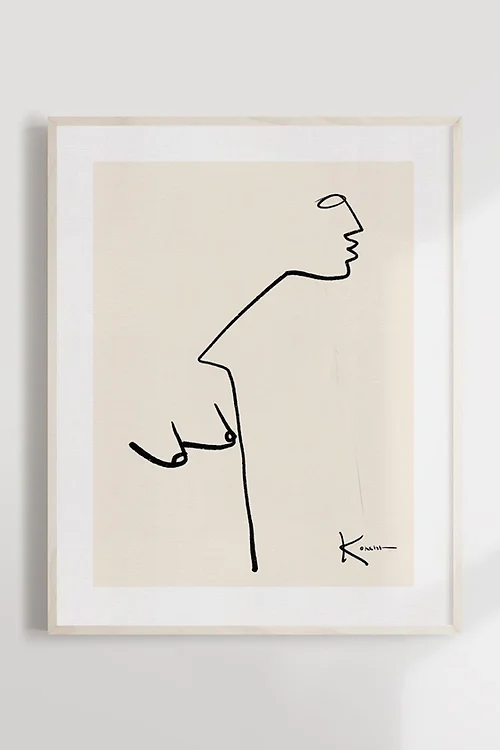
‘It’s just me’, 2021.
Gil: Does AI open up new possibilities?
Shira: With AI I have no limits. AI is allowing me to literally make anything I want. I can focus on visioning and imagining with AI, and whoever brand I collaborate with focus on making it into reality.
I use Midjourney. What I love about Midjourney is that it is very metaphoric to life, where you have to find your own way of solving problems. No one can do it for you. It is a tool like any other tool, and it is up to you to make it work. In that way, AI is totally about you. Sometimes people say to me, ‘The work is not really you; it is AI’, and I reply, ‘But it is my mind who worked it out, my head, I did it. It is not something that anyone else could do’. This is the same when people look at a Picasso work – his child-like drawings – and say, ‘Anybody can draw like that’. Well, if anybody can do that, why don’t you?… Sometimes when things look simple and easy to make people almost become antagonised by it, but also deep down it can inspire them the most because they can relate to it.

Ring ‘untitled’, photo created with AI, 2024.

Shirt ‘untitled’, photo created with AI, 2023.
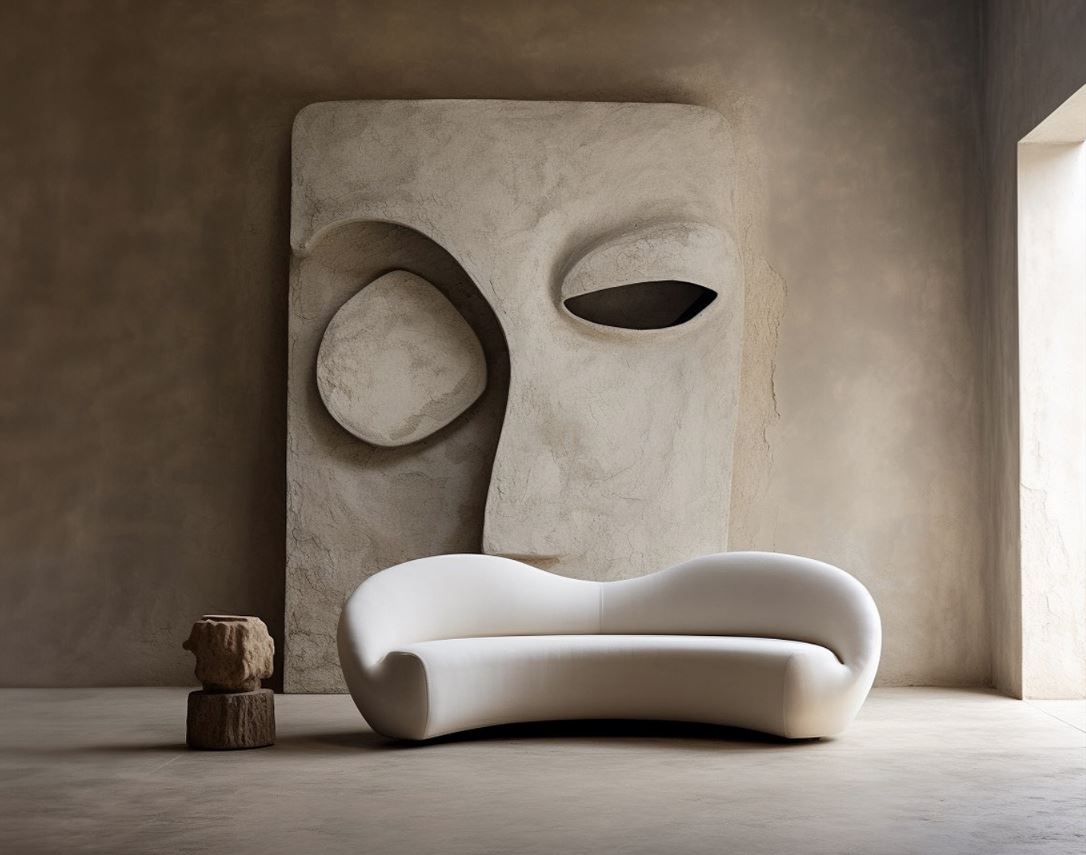
Furniture concept ‘Thy lips are sealed’, photo created with AI, 2023.
Gil: Your artistic style evolved by eliminating unnecessary elements?
Shira: Yes. My background is fashion. I studied fashion design. Then I geared towards fashion illustration. I worked in the fashion industry for many years. And I worked on brands like Roberto Cavalli, where ‘more’ was the aesthetic. I yearned to impress my clients as a freelance illustrator, and wanting to leave my mark. So, I embellished a lot. I had a lot of different techniques to make a drawing looks extravagant. It was all about the extravaganza. At some point, I started to deepen my connection with myself and the world. I started to get bored with this extravagant practice, and I felt it wasn’t really me. The exploration was to start to eliminate details. I asked myself, ‘Do I need this detail? No. Do I need this here? No, I do not need that.’ I do not need embellishments. And then after eliminating so many elements, I ended up with a line. I realised that I’m a minimalist. It was like one of those moments when you feel a strong connection to something. It is like being able to understand something without reading a single thing about it. You just know. I understand the simplicity, because I was in maximalism, and I shed it to find the truth. Minimalism seems more honest, humble and quieter. And it felt more sophisticated.
Gil: What about the use of colours in your work?
Shira: I use colour as a backdrop. I often like to draw on photos. So, the colour is always there to serve a purpose and not the subject itself. For instance, the colour would be the beautiful sunset.
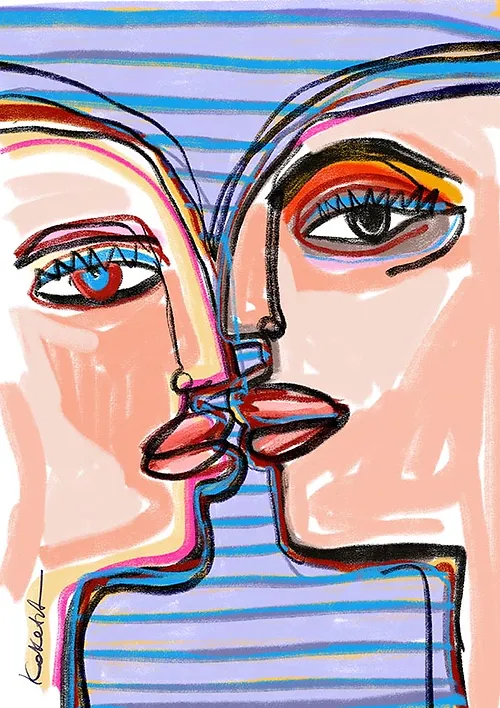
‘Kiss me you fool’, digital, 2021.
Gil: And shapes?
Shira: The shape makes the subject in my works. My subject is always the same – I’m always drawing a figure. I always draw the face and body, which are shapes. So, the shape is ultimately everything. The shape is the way I see the world. If I’m walking outside, and I look up at a tree, then all of a sudden out of the wood texture pops up a face. This happens to me all the time. If I’m looking at the sea, and the waves break on the cliffs, then the foam reminds me of the movement of the body. The shape is the connective tissue of everything.
At a glance:
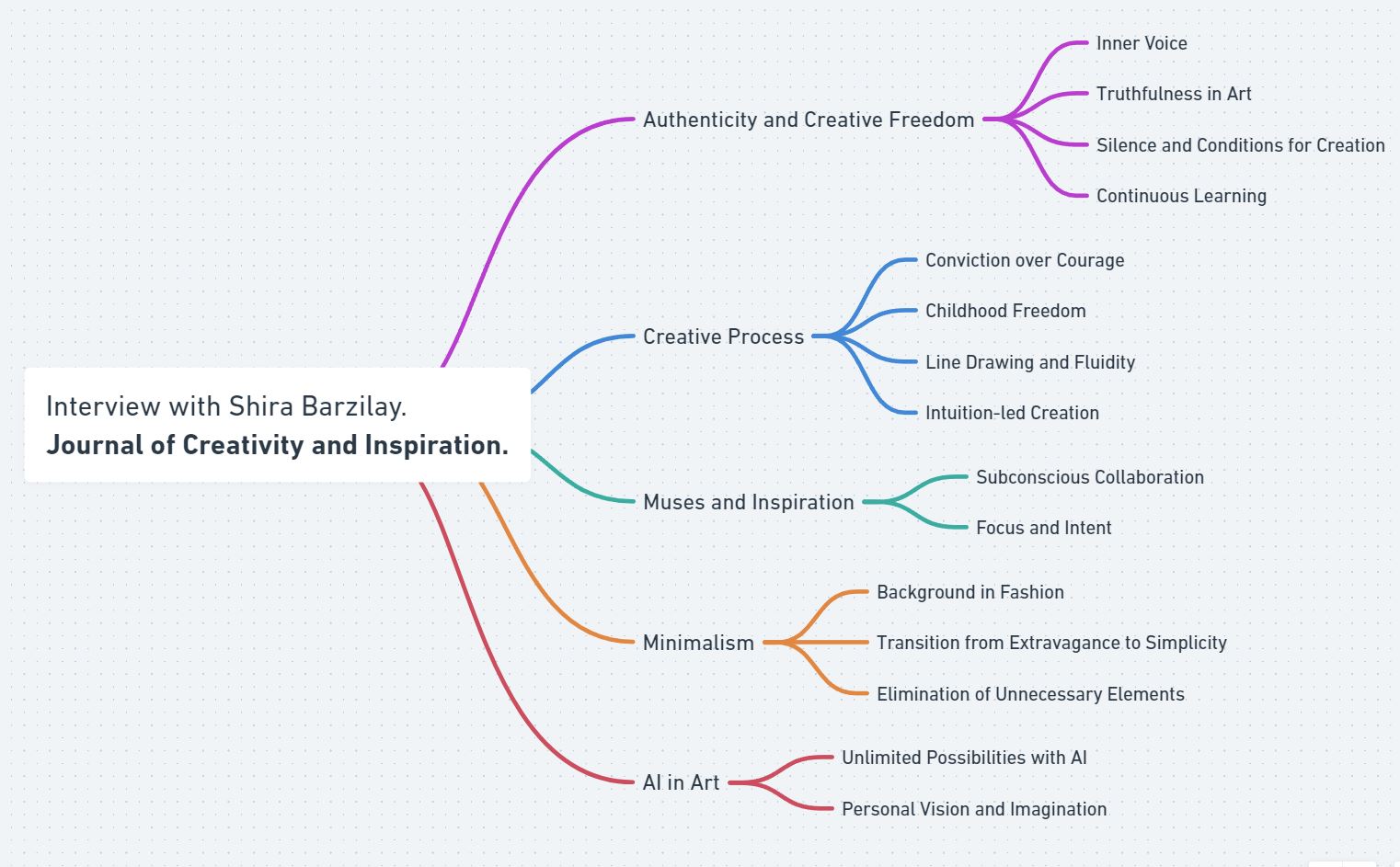
© Journal of Creativity and Inspiration.
Images/art © the artist.
Shira Barzilay is a visual artist, based in Tel Aviv, who specialises in digital art. She has collaborated with Cartier, Elizabeth Arden, Vogue Portugal, Harper’s Bazaar, N’kd, Lenovo, Revlon, and most recently a design collaboration with Zara.
Gil Dekel is a doctor in Art, Design and Media, specializing in processes of creativity and inspiration. He is a lecturer, visionary artist, Reiki Master/Teacher, and co-author of the ‘Energy Book’. He was awarded the Queen Elizabeth II Platinum Jubilee Coin, in recognition of his dedication and commitment to pastoral work at Hampshire Constabulary.
